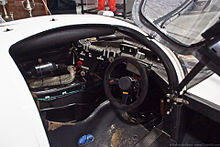
All American Racers is an American-licensed auto racing team and constructor based in Santa Ana, California. Founded by Dan Gurney and Carroll Shelby in 1964, All American Racers initially participated in American sports car and Champ Car races as well as international Formula One events with cars named Eagle. The Formula One team, based in the United Kingdom and using British-built Weslake engines was named Anglo American Racers. Under team manager Bill Dunne they set up shop in Rye, East Sussex. The team were adjacent to Harry Weslake's engine development plant and half a mile from Elva cars. They participated in 25 Grands Prix, entering a total of 34 cars.

The Porsche 962 is a sports prototype racing car designed and built by Porsche. Created to replace the Porsche 956, 962 was introduced at the end of 1984 and replaced the 956 in the IMSA's GTP class in 1985 due to regulation changes obsoleting the 956. It was also introduced in the World Sportscar Championship's Group C category in 1984. Over its decade-long career, the car in its Group C form won the 24 Hours of Le Mans twice, with a derivative of the car, the Dauer 962 Le Mans, winning a further title in 1994. In total, the 962 scored nineteen total constructor's championships across various series. The 962's successor was the Porsche WSC-95, introduced for the 1996 24 Hours of Le Mans, but did not receive factory backing or support.

The Jaguar XJR-9 is a sports-prototype race car built by Jaguar for both FIA Group C and IMSA Camel GTP racing. In 1988, Jaguar's XJR-9 won the 24 Hours of Le Mans, after debuting that year at the 24 Hours of Daytona.
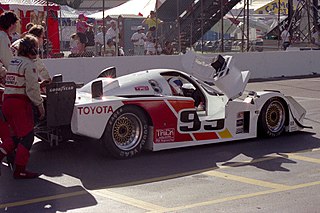
Juan Manuel Fangio II is an Argentine former auto racing driver. He is the nephew of five-time Formula One champion Juan Manuel Fangio.

The Jaguar XJR sportscars were a series of race cars used by Jaguar-backed teams in both the World Sportscar Championship (WSC) Group C and the IMSA Camel GTP series between 1984 and 1993.

Spice Engineering was a British racing team founded by driver Gordon Spice with Raymond Bellm in the early 1980s, later becoming a successful sports car constructor in 1986. They competed in the World Sportscar Championship in Europe as well as the IMSA GT Championship in North America, at times partnering with major manufacturers such as General Motors and Honda as well as race engine manufacturer Comptech.

IMSA GT was a sports car racing series organized by International Motor Sports Association. Races took place primarily in the United States and occasionally in Canada.
IMSA GT classes are former classifications of sports prototypes in sports car racing competing in the IMSA GT Championship. The classes were used at different, overlapping times during the period from 1971 to 1998, over which the championship ran.

The Chevrolet Corvette GTP was an American Grand Touring Prototype-class sports prototype racing car which successfully participated in the IMSA Camel GT from 1984 until 1989. The car was professionally fielded in competition as General Motors' Chevrolet Corvette C4 official factory team effort in the IMSA GTP class.
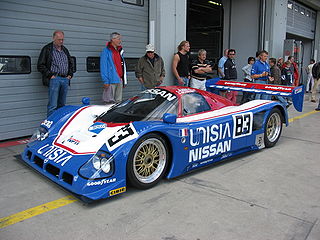
The Nissan R90C was a platform used for Group C racing cars built in 1990 by Nissan Motors for competition in World Sportscar Championship (WSC) based in Europe and the All Japan Sports Prototype Championship (JSPC). The cars based on the basic R90C platform would compete until 1993 before Nissan chose to withdraw from sports car racing, not returning until 1997. It won three JSPC championships and several significant endurance races during its career.
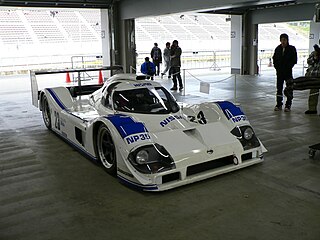
The Nissan P35 was a planned Group C car built by Nissan Motors for competition in the World Sportscar Championship. Developed by Nissan Performance Technology Inc. (NPTI), which had formerly raced under the name Electramotive in the United States, the cars were intended to be completed by the middle of 1992, with competition starting in 1993. However economic troubles for Nissan led to the cancellation of the project soon after testing of the first cars had begun, meaning that the P35s never raced.
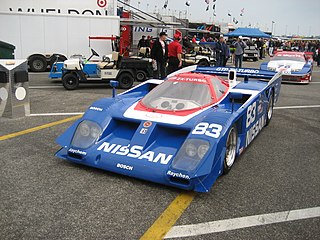
The Nissan GTP ZX-Turbo was a series of racing cars developed for Nissan Motors by Electramotive Engineering to compete in the IMSA GT Championship. Running from 1985 to 1990, they were known for being the first car to defeat the Porsche 962 which had dominated IMSA's premier GTP category. This led to Nissan winning the constructor's championship and 12 Hours of Sebring in 1989 and 1990. During 1990, the GTP ZX-Turbo was replaced by the newer NPT-90.

The Nissan NPT-90 was a racing car developed in 1990 for Nissan Motors by Nissan Performance Technology Incorporated (NPTI), formerly known as Electramotive Engineering. It was a replacement for the highly successful GTP ZX-Turbo that had won the IMSA GT Championship in 1989. The NPT-90 would go on to win the championship in 1990 and 1991 before being retired by Nissan at the end of the 1992 season.

The Mazda RX-792P is a sports prototype racing car built for the IMSA GT Championship's GTP category for Mazda. Its career was short lived, with only two cars running in 1992 before the project was abandoned.

The Riley & Scott Mark III was a sports prototype auto racing car developed by Bob Riley, Bill Riley and Mark Scott of Riley & Scott Cars Inc. Initially designed in 1993, the car was created for the World Sports Car (WSC) category which was to debut in the North American IMSA GT Championship during their 1994 season. It was not until 1995 that the first Mk III was completed, but the construction of further cars allowed a variety of teams to campaign in several North American and European racing series, including competing at the 24 Hours of Le Mans.

The Lola T600 was a racing car introduced in 1981 by Lola Cars as a customer chassis. It was the first GT prototype race car to incorporate ground-effect tunnels for downforce. The revolutionary aerodynamic design of the T600 was widely imitated throughout the 1980s by International Motor Sports Association (IMSA) and Group C prototype cars. The Lola T600 ran initially in the U.S.-based IMSA GT series and later in European Group C races.

The Eagle HF89 and its evolution, the Eagle HF90, is a racing car built and entered by Dan Gurney's All American Racers team, for the IMSA GT Championship. It was raced from 1989 until 1991 in IMSA's premier sports-car racing category, the GTP division. The design was also sometimes called the Eagle MkII.
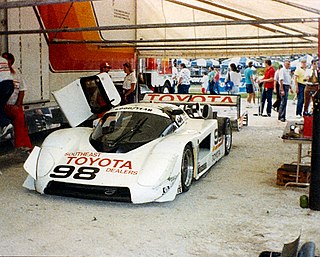
The Toyota 88C was a racing car entered by Toyota from 1988 to 1989. It is the successor to the Toyota 87C and the predecessor to the Toyota 88C-V. Like other Toyota-powered sports prototypes of the era, it was designed and built by Dome. The 88C is an evolution of the 87C, both models sharing the same chassis number designation. The 88Cs competed in the All Japan Sports Prototype Championship, the World Sports-Prototype Championship, and the North American Camel GT Championship.
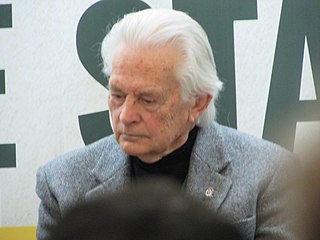
Tony Southgate is an English engineer and former racing car designer. He designed many successful cars, including Jaguar's Le Mans-winning XJR-9, and cars for almost every type of circuit racing. He was responsible for the chassis design of Ford's RS200 Group B rally car. Southgate was employed as chief designer or technical director for many Formula One teams for over twenty years. These teams included BRM, Shadow and Arrows. Southgate retired after producing the Audi R8C, which was a major influence in the Bentley Speed 8, which won Le Mans in 2003. He continues to be a regular visitor to current and historic race meetings.

The Intrepid RM-1 is a sports prototype racing car designed in 1991 by Bob and Bill Riley and built by Pratt & Miller to IMSA GTP specifications. Powered by a Chevrolet V8 engine, it was campaigned variously by Jim Miller, Prototype Technology Group and Wayne Taylor in the IMSA Camel GT from 1991 through 1993. Though it won only one race in its three seasons of competition, the shovel-nosed Intrepid was notable for the extreme—and at one point, disastrous—levels of downforce it generated, giving it the highest cornering speeds of any prototype of its era. The car's development was set back by a devastating 1991 crash at Watkins Glen that critically injured driver Tommy Kendall, and the program never fully recovered.

